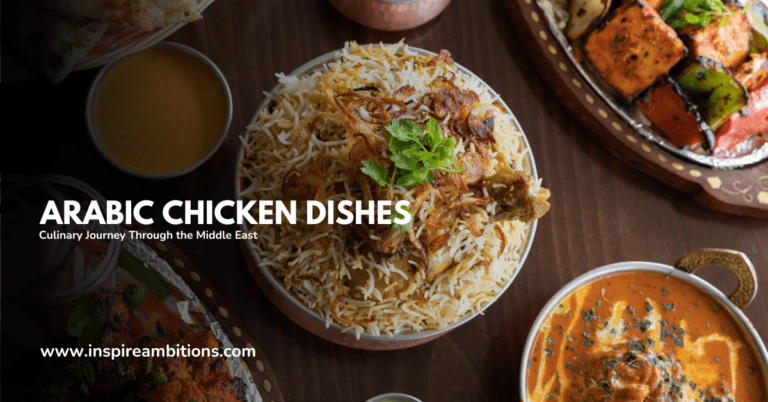আরবি শাওয়ারমা - খাঁটি স্বাদ এবং কৌশল উন্মোচন করা
Arabic shawarma has become not only a popular Middle Eastern street food but a dish that has spread across the globe, delighting taste buds everywhere.
Dating back to the Ottoman Empire, shawarma has its roots in a variety of regional cuisines, from Turkish doner kebab to Greek gyros.
The unique spices and flavours used in each region have come to define the dish, and the variety of toppings and preparation methods can be an exciting way for you and your palate to experience different culinary cultures.
The term “shawarma” itself is derived from the Arabic word that signifies the motion of turning, reflecting the cooking method involved in its creation.
Traditionally, seasoned meat is stacked on a vertical rotisserie and slowly roasted as it turns, allowing the juices and flavours to marinate the meat over time.
As it cooks, thin slices are shaved off to serve in a dish or as a sandwich, typically accompanied by an array of toppings and condiments such as tahini, hummus, pickled cucumbers, or amba.
While the dish originated in Lebanon, its undeniable charm and flavour profile have led to it becoming a staple in many রাস্তার খাবার scenes around the world.
Thanks to its versatility and the ease by which it can be adapted to suit local tastes, shawarma has truly become a beloved international dish.
Whether you eat it in a warm pita pocket or served on a plate with sides and sauces, this ever-evolving delicacy is worth seeking out and savouring.
The Origin of Shawarma
Shawarma has its roots in the Ottoman Empire, dating back to the 18th century, and the term itself stems from the Arabic word meaning “turning.”
This is a reference to the traditional cooking method, which involves layers of meat (usually lamb, beef, or other meat) marinated in a mixture of yoghurt, vinegar, and a variety of fragrant spices, being roasted on a revolving spit.
In the Middle East, particularly in countries like Lebanon and Turkey, shawarma has been a popular street food for many years. Over time, shawarma has evolved and adapted to different regional tastes, but its essential preparation and cooking methods remain largely the same. Today, it can be found throughout the world, and enjoyed by people of various cultures and backgrounds.
While shawarma is popular in many Middle Eastern countries, it shares similarities with other regional dishes such as the Greek gyros.
The difference lies primarily in the seasoning, with shawarma featuring more spices, while gyros are flavoured with more herbs. This distinction in taste has allowed shawarma to become distinct and widely recognised globally.
So, when you savour a shawarma, remember its rich history, the culinary journey it has travelled, and the cultures it represents.
What Makes Arabic Shawarma Unique?
When you explore Arabic shawarma, you’ll find it differs from other similar dishes in its flavour, preparation, and traditional presentation. The unique combination of spices, tender meat, and its long-standing history set shawarma apart from popular dishes like Greek gyros or Turkish döner kebab.
Firstly, what makes Arabic shawarma stand out is the mix of spices used for marinating the meat. Typical spices used in the marinade include cardamom, cinnamon, and nutmeg, all of which contribute to the dish’s distinct taste.
The meat, often lamb, beef, or poultry, is marinated in these spices along with vinegar, resulting in a juicy and delectable experience for your taste buds.
The cooking method also sets shawarma apart. After marination, the meat is placed on a vertical spit, where it slowly rotates, allowing it to cook evenly and retain its tenderness. The meat is then thinly sliced, and ready to serve.
Arabic shawarma is quite versatile in its presentation. You can enjoy it as a sandwich or a wrap, typically using pita or laffa bread. When served in pita bread, shawarma offers a portable and satisfying meal, making it a popular street food choice.
To summarise, the unique combination of spices, tender meat, versatile presentation, and slow-cooking method make Arabic shawarma not only distinctive but also a delightful culinary experience. Next time you come across this tasty dish, remember what sets it apart from other similar dishes and savour its flavours.
Ingredients of Arabic Shawarma
খুঁজে বের কর.
Protein Choices
Arabic shawarma offers a variety of protein choices which often include মেষশাবক, mutton, veal, beef, মুরগি বা turkey. These meats are thinly sliced, seasoned, and marinated using a combination of Middle Eastern spices. Some of the most commonly used spices are:
- জিরা
- পাপরিকা
- অলস্পাইস
- ধনে
- হলুদ
- Garlic powder
The marinated meat slices are stacked on a skewer and slowly roasted or braised, ensuring the meat remains tender and flavourful.
Vegetable Components
To complement the rich and aromatic meat, shawarma incorporates a range of fresh and pickled vegetables which can vary based on regional preferences. Some common vegetable components include:
- Romaine lettuce
- Sliced cucumber
- Thinly sliced onion
- Chopped tomatoes
- Pickles or pickled turnips
These vegetables not only add a crisp and refreshing contrast to the meat but also provide a variety of textures and flavours that elevate the overall shawarma experience.
Sauce Varieties
A major part of the deliciousness of Arabic shawarma lies in its accompanying sauces. Various sauces can be used, depending on regional and personal preferences. Some widely appreciated sauces are:
- Tahini sauce: A creamy, nutty sauce made from sesame seeds, lemon juice, and garlic, which adds a distinct savoury taste.
- Garlic sauce: A pungent and creamy sauce made with garlic, lemon juice, and oil, offering a tangy kick.
- Yoghurt sauce: A cooling sauce made with yoghurt, cucumber, and herbs, complementing the warmth of the spices in the shawarma.
Whether served as a sandwich wrapped in pita bread or on a plate, Arabic shawarma combines a richly marinated protein, fresh vegetables, and flavourful sauces, resulting in a mouthwatering culinary experience.
Arabic Shawarma Preparation
চল শুরু করি.
Marinating the Meat
To prepare Arabic shawarma, start by marinating the meat. Choose either beef or chicken and season it with a mix of warm Middle Eastern spices. A typical shawarma spice blend includes paprika, cumin, coriander, garlic powder, and a touch of cinnamon.
Don’t shy away from using a generous amount of spice mix to achieve flavourful and juicy meat. Once you have coated the meat with the blend, let it sit in the fridge, marinating for at least a couple of hours, or ideally overnight, to let the flavours fully develop.
Cooking Process
When ready to cook, preheat your oven and cook the marinated meat. For beef shawarma, layer the marinated slices on a vertical rotisserie or spit, slow-roasting it until the meat is perfectly tender and flavourful.
This process might take a few hours, depending on the thickness and size of your meat. For chicken shawarma, you have the option of oven baking, air frying, or cooking it in a cast iron skillet on the stovetop. No matter the method you choose, ensure the meat is cooked thoroughly and evenly.
Assembling the Shawarma
Finally, assemble the shawarma sandwich. Slice the cooked meat into thin pieces and set aside. Warm up some pita bread or flatbread, ensuring it’s pliable but not too crispy. Spread a generous amount of toum (garlic sauce) or hummus onto the bread as a base.
Lay the sliced meat onto the bread, followed by a combination of fresh toppings like tomatoes, cucumber, pickles, and onions. Optionally, you can add some tahini sauce or hot sauce for an extra burst of flavour. Wrap the sandwich tightly, enclosing all the fillings, and enjoy your homemade Arabic shawarma.
Serving and Pairing Suggestions
When it comes to enjoying Arabic shawarma, it’s important to find the perfect accompaniments to enhance the flavours and make your meal complete. Here are some delightful serving and pairing suggestions to elevate your shawarma experience.
Pita Bread:
Shawarma is traditionally served with pita bread, which is perfect for scooping up the succulent meat and its luscious sauces. Warm the pita bread before serving to make it even more delectable.
Mujaddara:
A delicious combination of rice, lentils, and onions, mujaddara makes a hearty side dish that complements the flavours of your shawarma. The earthy taste of the lentils and the sweetness of the caramelised onions are an ideal match for the spiced meat.
Tabbouleh Salad:
This vibrant salad combines bulgur wheat, fresh parsley, tomatoes, and a zesty lemon dressing. Tabbouleh is light and refreshing, making it a great choice to balance the richness of shawarma.
Chickpea Salad:
A tasty and nutritious option, chickpea salad features ingredients such as cucumber, red onion, and fresh herbs, all tossed in a tangy dressing. This adds a delightful crunch and depth of flavour to your meal.
Note: For a healthier option, consider these choices:
- Grilled Veggie Skewers: Colourful, flavourful, and easy to prepare, grilled veggie skewers provide a lighter, more nutrient-dense accompaniment to shawarma.
- Roasted Broccolini: Simply toss broccolini in olive oil, season with salt and pepper, and roast until tender and slightly charred. This makes for a delicious and nutritious addition to your shawarma feast.
- Pickled Red Cabbage: For a tangy and colourful side, this pickled red cabbage adds a burst of flavour and a lovely crunch to your meal.
Next time you’re enjoying an Arabic shawarma, try some of these serving and pairing suggestions to make your meal truly memorable.
Variations of Arabic Shawarma
Regional Differences
As you delve into the আরবি বিশ্ব shawarma, you’ll discover a range of regional differences that contribute to the dish’s diverse flavours. For instance, Lebanese shawarma traditionally consists of marinated lamb or veal, seasoned with fresh mint, thyme, parsley, black pepper, white pepper, bay leaf, and nutmeg.
In comparison, Turkish shawarma called “döner kebab” is often made using a mix of chicken, beef, or lamb, and seasoned with a blend of garlic, paprika, cumin, and oregano.
Moreover, different regions use unique sauces and accompaniments to complement their shawarma. In the Levant, mainly in Lebanon and Syria, you might find garlic sauce known as “toum” accompanying the dish, while in Iraq, they often use tomato-based “amba” sauce.
Contemporary Twists
While shawarma owes its origins to মধ্যপ্রাচ্যের রান্না, it has been embraced by various cultures worldwide, each adding its unique spin. Some contemporary adaptations include:
- Vegan shawarma: Swapping out meat for plant-based alternatives such as seitan, chickpeas, or jackfruit, which are marinated in a similar blend of spices and served with classic accompaniments.
- Shawarma bowls: Instead of being served on pita bread or wraps, these bowls feature tender shawarma meat on a bed of rice, quinoa, or fresh lettuce, combined with an assortment of toppings and sauces.
- Fusion shawarma: Combining the traditional Middle Eastern dish with other well-known international foods, giving birth to dishes like shawarma tacos, pizza, sushi, or burritos.
In conclusion, Arabic shawarma is a versatile dish that comes in many forms, influenced by regional preferences and creative culinary innovations. Whether you prefer a more traditional approach or are eager to try contemporary twists, there’s sure to be a shawarma variation that appeals to your tastes.
Cultural Significance of Arabic Shawarma
As a lover of আরবি খাবার, you’d be fascinated by the cultural significance of shawarma. Originating in the Ottoman Empire, this Middle Eastern dish quickly gained popularity in various regions of the world due to its enticing flavours and distinctive preparation method.
Shawarma involves stacking meat in thin slices, forming an inverted cone, and roasting it on a slowly turning vertical rotisserie or spit.
Shawarma holds strong connections to the culinary traditions of the Middle East. Traditional shawarma uses lamb, mutton, chicken, turkey, beef, or even veal, offering a delightful array of flavours specific to various regions. As an essential street food, it provides accessible and delicious nourishment to people throughout the day.
The widespread influence of shawarma is primarily attributed to Arab immigrants who brought their cherished dish with them as they settled in different countries.
Through this movement, shawarma assimilated into diverse cultures and became a part of the global culinary landscape. Today, you can find shawarma from London to Los Angeles and Tokyo, a testament to its adaptable nature and appeal.
In addition to its cultural significance as a culinary staple, shawarma also serves as a symbol of unity and bonding within communities. The shared experience of enjoying a warm, satisfying meal together fosters a feeling of togetherness and strengthens social bonds among people from various backgrounds.
The simplicity of the preparation and the rich flavours that emerge from this ancient cooking technique stand as a reminder of the invisible ties that bind people all across the globe.
Whether you’re savouring authentic shawarma in the Middle East or enjoying an innovative take on the dish in a bustling metropolis, you’re participating in a rich cultural tradition that has bridged borders and spoken to countless taste buds throughout history.
So, the next time you relish shawarma, know that you’re not just indulging in a tasty meal, but you’re also embracing the cultural and historical significance of a truly global dish.
পুষ্টির মান
When it comes to the nutritional value of Arabic Shawarma, there are a few factors that contribute to the number of calories and nutrients in this popular dish. The ingredients used in shawarma, such as the type of meat, sauces, and bread, can greatly affect the overall nutritional content.
A typical Arabic shawarma contains 3 ounces of shredded chicken, which is rich in protein. This, combined with a tablespoon of hummus এবং a tablespoon of mayo sauce, wrapped in an 8-inch roti or bread, results in around 600 calories per serving.
However, it’s important to note that the calorie count may range from 300 to 800 kcal, depending on the portion size and additional ingredients like cheese or extra sauce.
In addition to calories, shawarma offers a variety of nutrients. Here’s a breakdown of the primary nutritional components of a typical shawarma:
Total Fat: 24g (31% of Daily Value)
- Saturated Fat: 7.9g (40%)
- Polyunsaturated Fat: 2.1g
- Monounsaturated Fat: 9.6g
Cholesterol: 200mg (67% of Daily Value)
সোডিয়াম: 602 mg (26% of Daily Value)
Total Carbohydrates: 58g (21% of Daily Value)
- Dietary Fiber: 2.8g (10%)
- Sugars: 3.1g
প্রোটিন: 78g
Aside from the macronutrients mentioned above, shawarma also provides some essential vitamins and minerals. One serving can offer 10% of your daily calcium requirements, which is important for strong bones.
To keep your shawarma healthier, you can make some adjustments to the ingredients. For instance, opt for whole wheat or lower-carb bread, choose leaner cuts of meat, and limit the amount of high-calorie sauces.
You can also add more vegetables, such as lettuce, cucumber, and tomatoes, to increase the nutritional value and fibre content of your shawarma.
In conclusion, Arabic shawarma can be a delicious and satisfying meal that provides a good amount of protein and other nutrients. Just remember that calorie counts might vary, so be mindful of your portion sizes and ingredient choices to maintain a balanced diet.
Arabic Shawarma – Conclusion
In conclusion, shawarma is a delicious and popular Middle Eastern dish that originated in the Ottoman Empire. It is made using marinated meat, which can include lamb, beef, chicken, goat, turkey, or a combination of these. The meat is slow-roasted on a vertical spit for several hours and then carved into thin slices to be served.
Throughout its history, shawarma has expanded in popularity across the globe, becoming a beloved street food in many countries, including Europe, Israel, and Turkey.
Its appeal is not limited to non-vegetarians, as vegan versions of shawarma exist, using roasted vegetables as a substitute for meat. Its versatility, combined with its tantalising flavours, ensures it will continue to be enjoyed by people all over the world.
As you savour your next shawarma, appreciate the rich history behind this dish, and the diverse methods of preparation seen in various locales. From its Middle Eastern roots to its modern-day adaptations, shawarma has truly earned its spot as a global culinary treasure.






